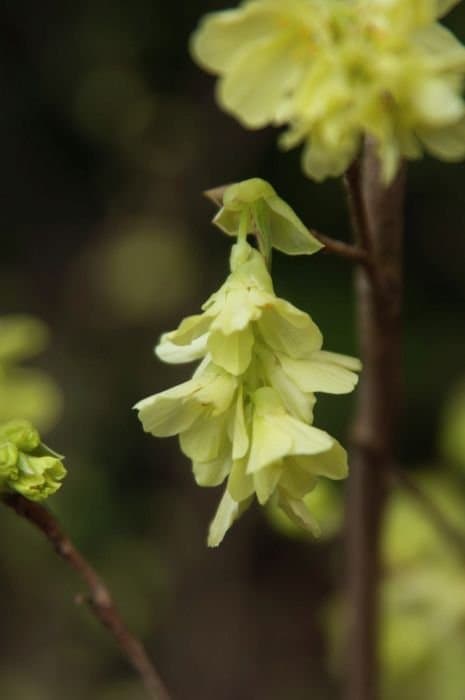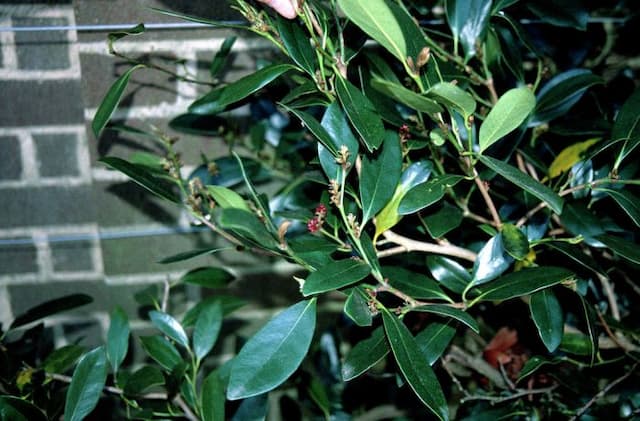Witch hazel 'Barmstedt Gold' Hamamelis × intermedia 'Barmstedt Gold'

ABOUT
'Barmstedt Gold' is a deciduous shrub with hazel-like foliage and large, fragrant, deep golden-yellow flowers on the bare twigs in late winter and early spring; some yellow autumn colour
About this plant
 Names
NamesFamily
Hamamelidaceae
Synonyms
Witch Hazel, Winterbloom
Common names
Hamamelis × intermedia 'Barmstedt Gold'.
 Characteristics
CharacteristicsLife cycle
Perennials
Foliage type
Deciduous
Color of leaves
Green
Flower color
Yellow
Height
12 feet (3.66 meters)
Spread
12 feet (3.66 meters)
Plant type
Shrub
Hardiness zones
5
Native area
Asia
Benefits
 General Benefits
General Benefits- Ornamental Value: Hamamelis × intermedia 'Barmstedt Gold', commonly known as witch hazel, is highly prized for its vibrant yellow flowers that bloom in late winter to early spring, providing color and interest during a time when few plants are in flower.
- Winter Interest: The plant's unique, fragrant flowers appear on bare branches, offering aesthetic appeal in a seasonally dormant garden.
- Attracts Wildlife: Witch hazel flowers are a source of food for early-foraging bees and other beneficial insects, encouraging biodiversity.
- Low Maintenance: Once established, witch hazel requires minimal care, making it a good choice for low-maintenance landscapes.
- Drought Tolerance: After establishing a strong root system, it shows a degree of drought tolerance, reducing the need for frequent watering.
- Fall Foliage: The plant has attractive fall foliage, with leaves turning a variety of colors from yellow to orange to red, adding another season of interest.
- Hardiness: It is generally hardy in temperate climates, tolerating a range of winter temperatures.
- Versatility: Witch hazel can be used in various landscape settings, including as a specimen plant, in mixed borders, and in woodland gardens.
- Tolerates Various Soils: It grows well in a range of soil types, as long as the soil is well-draining.
 Medical Properties
Medical PropertiesThis plant is not used for medical purposes.
 Air-purifying Qualities
Air-purifying QualitiesThis plant is not specifically known for air purifying qualities.
 Other Uses
Other Uses- Photography: The vibrant yellow flowers of the Witch Hazel 'Barmstedt Gold' can be used as a stunning subject in close-up and macro photography, providing a colorful contrast in winter landscapes.
- Artistic Inspiration: Artists may use the unique form and color of the Witch Hazel 'Barmstedt Gold' branches as inspiration for paintings, drawings, and other forms of visual art.
- Craft Material: The twisted branches of Witch Hazel 'Barmstedt Gold' can be harvested and used in floral arrangements or for crafting wreaths and other decorative items.
- Winter Garden Design: Witch Hazel 'Barmstedt Gold' can be strategically planted in gardens to add winter interest due to its late winter blooms when most other plants are dormant.
- Wildlife Shelter: Birds and small animals often use the dense branches of Witch Hazel 'Barmstedt Gold' for shelter during the winter months.
- Natural Fencing: When planted in a row, Witch Hazel 'Barmstedt Gold' can provide a semi-deciduous screen or hedge, offering some privacy while maintaining a natural look.
- Education: Botanical gardens and educational programs use Witch Hazel 'Barmstedt Gold' to teach about plant adaptation, particularly how some species bloom in the cold season.
- Ephemeral Art: The petals of Witch Hazel 'Barmstedt Gold' can be used in the creation of short-lived, nature-based artworks known as ephemeral art.
- Weather Indicator: In some cultures, the blossoming of Witch Hazel 'Barmstedt Gold' is used as a phenological sign that indicates the transitioning from winter to spring.
- Culinary Decoration: Though not commonly known for edible use, the non-toxic Witch Hazel 'Barmstedt Gold' flowers can be used as a decorative garnish on special dishes, adding a splash of color.
Interesting Facts
 Feng Shui
Feng ShuiThe Witch Hazel is not used in Feng Shui practice.
 Zodiac Sign Compitability
Zodiac Sign CompitabilityThe Witch Hazel is not used in astrology practice.
 Plant Symbolism
Plant Symbolism- Healing: Hamamelis, commonly known as Witch Hazel, has historical uses as a medicinal plant with healing properties, particularly known for its soothing and astringent qualities.
- Protection: Witch Hazel is also often associated with protection, as its branches were traditionally used for dowsing, which is believed to help locate water or ward off negative energies.
- Adaptability: 'Barmstedt Gold', as a variety of Witch Hazel, flowers in winter, symbolizing the ability to thrive and bloom even in adverse conditions, reflecting adaptability and resilience.
- Uniqueness: The distinctive bright yellow flowers of 'Barmstedt Gold' in the cold season can symbolize uniqueness, standing out in a time when most other plants are dormant.
 Water
WaterWitch Hazel 'Barmstedt Gold' should be watered regularly, ensuring that the soil remains evenly moist but not waterlogged. During the growing season, this might mean watering once a week with approximately 1-2 gallons of water, depending on climate conditions and soil drainage. During periods of drought or extreme heat, you may need to water more frequently. During the winter when the plant is dormant, water less often but do not allow the soil to completely dry out.
 Light
LightWitch Hazel 'Barmstedt Gold' thrives in full sun to partial shade. The best spot for the plant would allow direct sunlight for several hours a day, preferably in the morning with some afternoon shade. This balance promotes healthy growth and abundant flowering. Avoid deep shade as this will reduce the plant's flowering potential.
 Temperature
TemperatureWitch Hazel 'Barmstedt Gold' can tolerate temperatures as low as 0° Fahrenheit and as high as it gets in most temperate climates. The ideal temperature range for this witch hazel is between 35°F and 75°F. It is cold-hardy and adapts to seasonal temperature changes typical of many temperate regions.
 Pruning
PruningWitch Hazel 'Barmstedt Gold' should be pruned to maintain shape and remove any dead or crossed branches. The best time for pruning is in the spring after the plant has finished flowering. Prune sparingly, as witch hazels do not require heavy pruning; every 1 to 3 years will be sufficient to keep the plant healthy and well-shaped.
 Cleaning
CleaningAs needed
 Soil
SoilWitch hazel prefers well-drained soil rich in organic matter with a slightly acidic pH of 5.5 to 6. The best soil mix includes one part garden soil, one part peat moss or leaf mold, and one part perlite or coarse sand to ensure proper drainage and aeration.
 Repotting
RepottingWitch hazel typically does not require frequent repotting and can be done every 3 to 5 years. Repotting is best done in the spring before the growing season begins.
 Humidity & Misting
Humidity & MistingWitch hazel thrives in average humidity levels but is adaptable to both higher and lower humidity conditions, making it versatile for various environments without specific humidity requirements.
 Suitable locations
Suitable locationsIndoor
Provide bright light, cool temps, and good air circulation.
Outdoor
Plant in sun to part-shade; mulch well; protect from wind.
Hardiness zone
5-9 USDA
 Life cycle
Life cycleWitch Hazel 'Barmstedt Gold' starts its life as a seed, requiring stratification to break dormancy. Once germinated, the seedling establishes itself and begins vegetative growth, developing into a multi-stemmed shrub with distinctive broad leaves. It enters a phase of maturity where it blooms in late winter to early spring, producing fragrant yellow flowers before the emergence of leaves. Throughout the growing season, the leaves turn green and then transition to a vibrant yellow in autumn, after which they fall, and the plant enters dormancy. During dormancy, energy is conserved and redirected to support the next year's growth and flowering. This cycle repeats annually, with the shrub gradually increasing in size and branching complexity over the years.
 Propogation
PropogationPropogation time
Early spring
The most popular method of propagating Witch Hazel 'Barmstedt Gold' is through softwood cuttings, which is typically done in late spring or early summer when new growth is still flexible. To propagate, one would cut a 4 to 6 inch (10 to 15 cm) piece of softwood from the current year's growth, ensuring that there are at least two sets of leaves on the cutting. The bottom set of leaves should be removed, and the cut end dipped into rooting hormone to encourage root development. The prepared cutting is then inserted into a pot filled with a mixture of peat and perlite, ensuring good contact between the cutting and the medium. The pot should be kept in a warm and humid environment, often covered with a plastic bag or placed inside a propagator to maintain moisture levels. Roots typically develop within 4 to 8 weeks, after which the new plant can be gradually acclimated to outdoor conditions.









